Radecznica – Kurkowe Dołki
Borough of Radecznica, Zamość District, Lubelskie VoivodshipType of place
A grave of 4 people in the so-called Kurkowe Dołki – October 1942. A single grave on a pasture in the so-called Kurkowe Dołki, 2 February 1943 (currently – an arable field.)Information about the crime
The existence of unmarked Jewish graves of the Holocaust victims in the village of Radecznica was brought to our attention by a letter from Stanisław Zybała (a resident of the village, born in 1930) written on 6 October 2010 to the Jewish Religious Community in Lublin and passed over to the Rabbinic Commission for Cemeteries. There was a map drawn by Mr Zybała and attached to the letter which indicated the sites of burial of the murdered Jews. In his letter and during two meetings with us Mr Zybała described the following events:
A grave of 4 people in the so-called Kurkowe Dołki – October 1942:
“Here in 1942 policeman Baranowski shot to death three children of Lejzor Honig and their friend from a family unknown to me. There were four children altogether. They were shot here, on the road between Gankowski’s and Józiak’s [houses.] I saw them being undressed from the outer garments. Then one of the residents came, Walenty Mucha with his son Jan and [also] Stanisław Jezierski, they threw the bodies on their cart, took them to Kurkowe Dołki and buried there. Now it is an arable field. […] Once I went to school and looked into the register and wrote down all the names and surnames. I’ve got them here: Szloma Honig, Honig Dawid, Honig Herszak, Honig Jenczak, Honig Lenzor, Honig Łajka, Honig Małka, Honig Niuńka, Honig Szlajfer, Honig Gitla… this was Lejzor’s daughter. She was born on 28 May 1928 and her brother Szloma was born in 1922, I don’t know the day and month. I’ve got only those two. But there were three children of Lejzor Honig, Gitla, Raźla and Szloma and a fourth girl, more or less the same age, killed with them. And they were buried in Kurkowe Dołki, as I said… In a beautiful place. It was a small hollow in Kurkowe Dołki, a nice place and it was there. They were four of them there. When policeman Baranowski shot them, they were buried in Kurkowe Dołki by Walenty Mucha and his son Jan and another neighbour assigned to the burial, Stanisław Jezierski. They went to the place of execution, put them on their cart, took them to Kurkowe Dołki and buried them there, gave them a funeral.” (Radecznica, 28 July 2013.)
A single grave on a pasture in the so-called Kurkowe Dołki, 2 February 1943:
“The fifth person of the Judaic religion buried in Kurkowe Dołki was Mieczysław Bresler. It was on 2 February 1943 – Mieczysław Bresler, a son of a dentist from Lviv. They used to live at Lejzor Honig’s. There were three of them: Hipolit, the mother, Sabina Bresler and him, Mieczysław Bresler. He was shot by a policeman. I saw him being led by a policeman on a chain, like a prisoner. At some point on the road, which is currently called Prus Street, my friend and I saw a policeman leading a man. After a short while we recognized him – we knew both Mieczysław and Hipolit. They had been living here for a year or more. Bresler was chained with his right hand and the policeman held him with his left hand. When we saw Bresler led by a policeman we knew that the man is led to be shot – if he is led by a policeman with a rifle on his back. I was 12 years old then and my friend, Stach, was 14 years old. In 1942 everyone knew it meant death. We started following them in a distance of about 150-200 metres. We wanted to see where the policeman was leading Mietek. He took him to the so-called pasture and there they turned right. The pasture is now the beginning of the Insurgents Gorge. They turned right, he led him alongside the pasture, took him to the house where Kuba Kanikowski used to live. And there they stopped. He took the chain off, told him [the prisoner] to stay put, walked backwards [a bit], took the rifle off his shoulder, aimed and shot. He shot but Bresler didn’t fall, he was still standing. And we just came, we were standing just in front of them. We watched. After the first shot Bresler didn’t fall. The policeman reloaded the rifle, aimed again and shot. And the man who was being killed rised and fell into the snow. The policeman waited for w while, put the rifle back on his shoulder, looked back and walked away. He walked towards the main road. When he reached Kłodnicki’s and Krzyszczak’s [houses], Stach and I ran as fast as we could to see that man. He was lying with his face in the snow, his arms stretched to the back, a speck of blood next to his head. Why? We were both pondering. When [the policeman] shot the first time, the bullet only grazed his ear. He had to repeat the shot to kill him. I remember his hands, they were brown. Probably because of where he lived, where he was hiding… where he was caught. So there are five people buried in Kurkowe Dołki.” (Radecznica, 28 July 2013.)
IDENTIFICATION OF THE GRAVE BASED ON NON INVASIVE RESEARCH
On the 15th of October 2014, a local vision of the approximate place of the mass grave indicated by the witness was carried out. The precise location of the grave could not be determined (GPS: N50°44.532′ E022°49.466′).
No GPR surveys were conducted.
The LIDAR survey is not helpful in this case.
The aerial photography query for this area wasn’t ordered.
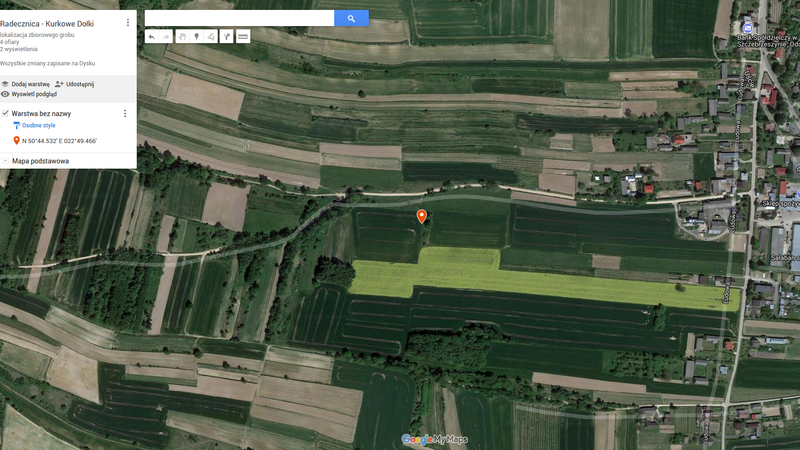 Radecznica - Kurkowe Dołki fotografia satelitarna 2 lokalizacji Kurkowe Dołki
Radecznica - Kurkowe Dołki fotografia satelitarna 2 lokalizacji Kurkowe Dołki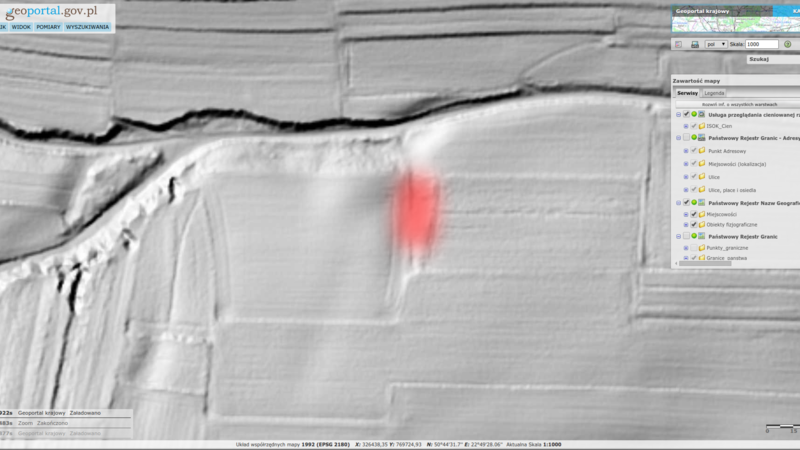 Radecznica - Kurkowe Dołki lidar 1e kurkowe dołki
Radecznica - Kurkowe Dołki lidar 1e kurkowe dołki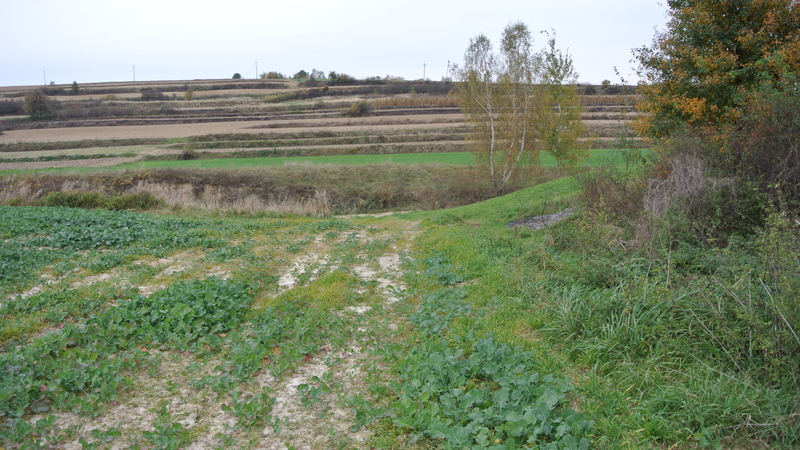 Radecznica - Kurkowe Dołki fotografia 3 lokalizacja kurkowe dołki
Radecznica - Kurkowe Dołki fotografia 3 lokalizacja kurkowe dołkiTranskrypcje
Contact and cooperation
We are still looking for information on the identity of the victims and the location of Jewish graves in Radecznica. If you know something more, write to us at the following address: fundacjazapomniane@gmail.com.
Bibliography
Recording of the Zapomniane Foundation (audio file), name: Stanisław Zybała [eyewitness], b. 1930, subject and keywords: Jewish graves in Radecznica, interviewed by Agnieszka Nieradko, Radecznica, 28 July 2013.
Zybała M., Zybała Rozwar S., Tak Cię widzę Radecznico, Radecznica 1998-2000.
Grzeszkiewicz Smoter R., Zybała Rozwar S., Ludność żydowska w gminie Radecznica, Szczebrzeszyn 2015.
GK 163/19, p. 1299, Questionnaire of places and facts of German crimes carried out by town courts. Lublin province. Questionnaire. Executions. Graves Lubelskie province; vol. 8, p. 1299.
IPN BU 2448/607, 608, Questionnaires of the Chief Commission for the Examination of German Crimes in Poland, Zamość district.
IPN BU 2448/608 from the files of the group Questionnaires of the Chief Commission for the Examination of German Crimes in Poland.
IPN Lu 1/13/78 cards 140, 140v, 141, 141v, the former Regional Commission for the Examination of German Crimes in Lublin, Questionnaire of places and facts of German crimes, Zamość district.
The register of sites and crimes committed by the Germans in Poland between 1939 and 1945, Warsaw 1994, Zamojskie province, p. 110.
A letter by Stanisław Zybała of 6 October 2010 to the Jewish Community in Lublin on Jewish graves in Radecznica along with a handwritten map of the place where the author marked the approximate locations of burial sites.
Marianna Zybała’s statement of 23 May 2016 on the location of the grave on the so-called “Drugie Doły” certified by the Commune Office in Radecznica.
Grzeszkiewicz Smoter R., Zybała Rozwar S. Rzeczpospolita Radecznicka, Lublin 2008 p. 120-126.
Zybała Rozwar S., Ulice Radecznicy, Szczebrzeszyn 2015.
Grzeszkiewicz Smoter R. Poza miastem poza historią. Rzecz o szczebrzeszyńskich Żydach, Szczebrzeszyn 2016.
Materials regarding Jewish war graves in Radecznica (transcripts of witness testimonies, video and audio files with eyewitness accounts) were prepared thanks to funding from the association of Jewish Historical Institute as part of the project: “Jewish War Graves. Documentation.”
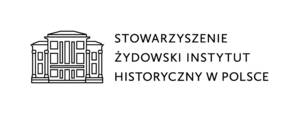
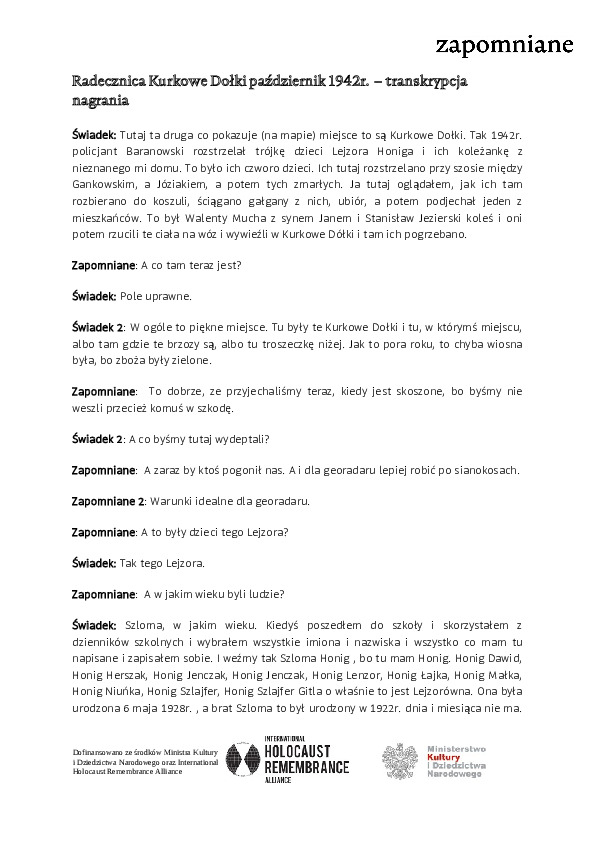 Radecznica Kurkowe Dołki - transkrypcja nagrania
Radecznica Kurkowe Dołki - transkrypcja nagrania